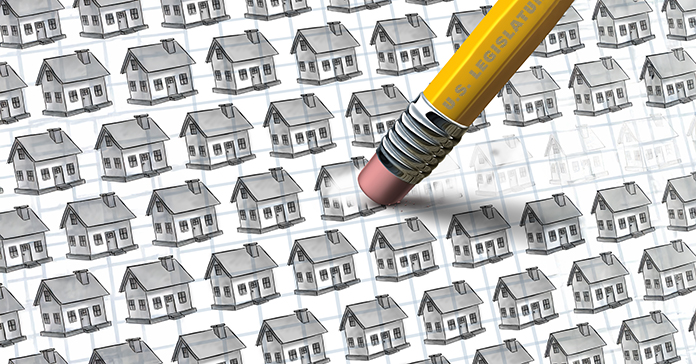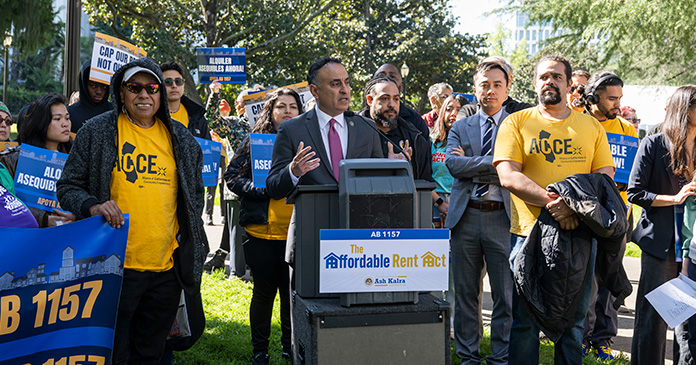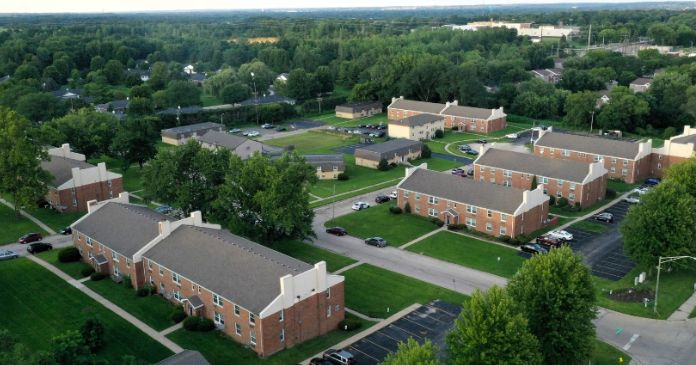Green building advocates and environmental scientists have brought a new level of awareness to the impact that buildings — most notably through energy use — have on the environment. It probably doesn’t take a scientist today to recognize that reduced energy use decreases our reliance on fossil fuels and helps counter pollution. Similarly, environmentally conscious decisions, whether in manufacturing, building, or consumer purchases, contribute to cleaner air and water, conserved habitats, and less polluted landscapes.
As the green building movement continues to mature, emerging scientific data are bringing focus on an environmental issue that hits much closer to home — to the direct impacts that building activity and its associated industries have on human health — how we breathe, function, and thrive every day in our environments, and to our long-term well-being. Cutting edge discussions in this emerging field are taking place around this very issue.
Respiratory health was the first human health concern brought to the forefront recently in relation to building practice. Ironically, it was attempts at energy conservation in the seventies and eighties that brought it to light. Tight building construction designed to keep air from leaking out succeeded in saving energy, but also kept fresh air from moving in. Reduced HVAC capacity further reduced the amount of fresh air circulating through a building.
Super-insulated structures that don’t have adequate ventilation are holding tanks for dust, moisture, and biological contaminants such as mold spores, pollen, viruses, and bacteria in the indoor environment, as well as chemical contaminants and radon. Sick Building Syndrome (SBS) is an oft-cited name for buildings that simply don’t function for human health. Symptoms associated with SBS include headaches, nausea, disorientation, allergies, respiratory problems, eye and nose irritation, itchy skin, and, as we are finding out, even more serious problems. According to the U.S. Environmental Protection Agency, pollution levels inside buildings can be anywhere from two to one hundred times higher than those outside. The agency links poor indoor air quality to the dramatic rise in childhood asthma.
State regulations and local building codes are now requiring a better balance of energy conservation with requirements for ventilation, and the industry in general is making concerted efforts to deal with mold.
But the relationship between human health and building practice is more subtle and complex than that. Energy efficiency measures coincided with other advances in building technology, which brought many new materials into the human environment. These include synthetic and composite materials, the incorporation of complex chemicals into products to improve performance, and introduction of plastics to serve human needs.
Building products that are made up of or incorporate synthetics and added chemicals include particleboard, PVC pipes, wiring, vinyl siding, insulation, cabinetry, pressure-treated wood for playgrounds and decking, sideboards, wall coverings, appliances, paint, carpeting, flooring, adhesives, windows, and fixtures. In addition, occupants bring in furnishings and consumer products that contribute a wide array of chemicals to the indoor environment.
John Spengler, professor and senior researcher at the Harvard School of Public Health and his team follow 80 chemicals known to cause health problems in humans and other organisms. “We’re finding that all homes today have measurable amounts of 25 to 30 carcinogens and other hazardous substances in their air,” says Spengler. “It’s not just one-time exposure to a toxin that is the problem. We’re finding evidence about the detrimental effects of cumulative, low-dose exposure.”
An overview of substances released over the life of buildings reveals a veritable sorcerer’s brew of chemical compounds. They include heavy metals such as mercury, lead, and arsenic — linked to neurological and brain damage, kidney disease, birth defects, and cancer; a group of chemicals called Volatile Organic Compounds (VOCs) known to cause cancer, bronchitis, asthma, central nervous system damage, kidney disease, and a host of allergies. Developing fetuses and young children are most vulnerable.
The key to understanding the link between building materials and human health is recognizing that the materials we use in buildings and homes are not neutral. They continue to interact with the environment and humans throughout the course of their use and even disposal.
Take paint, for example. A typical indoor paint used in homes and multifamily buildings may have hundreds of components. The “just painted” smell signals the release or “off-gassing” of chemicals, including VOCs, into the surrounding air. These chemicals are absorbed through breathing and the skin by paint crews and building inhabitants. Similarly, newly installed carpets and adhesives off-gas, initially in higher doses, and then in continuous lower doses over time.
Managers of buildings may want to note that the health impacts of synthetic carpets may actually get worse with cleaning. While dirt is pulled out of the synthetic fibers, residue from cleaning products, combined with moisture, attract new chemicals and molds. That’s why many rooms with wall-to-wall carpeting don’t “feel” clean after a number of years, even if cleaned regularly. Good ventilation is essential in such a chemically loaded environment.
THE DANGERS OF PVC
Vinyl and other polyvinyl products may be the most controversial of all building products in use today. Polyvinyl chloride (PVC) is used in a variety of common building products as well as car components, children’s toys, credit cards, plastic bottles and bags, consumer electronics, and medical equipment. Vinyl is useful, versatile, and cheap. The building industry today makes up the largest market for PVC products, or about 75% of demand. The use of PVC in construction doubled between 1980 and 1995.
The problem with vinyl is not its performance, but rather its complex chemical structure and its irreversible, profound effect on human and environmental health. PVC manufacture invariably releases dioxin, vinyl chloride, and other harmful chemicals. Dioxin alone is so toxic that the U.S. EPA has been unable to establish safe levels for its presence. Yet it is so pervasive that traces of it are found in northern Canadian streams and human breast milk. Dioxin health impacts are consistent with those caused by heavy metals and VOCs, but to a much greater degree, and additionally include endocrine disruption, immune and nervous system damage, cognitive disorders, and reproductive problems. Communities in the vicinity of vinyl production plants have disproportional rates of cancer, endometriosis, and learning disorders among children.
The aging of vinyl during its use eventually releases vinyl chloride particles, lead, cadmium, and toxic phthalate plasticizers used to enhance its flexibility. A 30-year study in Sweden found a high correlation between the presence of phthalate dust in homes and cases of asthma, allergies, and eczema among children. The worst health results were found in households where the phthalate dust was present in bedrooms — the space where our immune systems are most vulnerable during rest. Research shows that water damage to vinyl tiles and cleaning products releases phthalates and other toxins into the air.
PVC products are extremely difficult to recycle due to their complex chemistry. PVC disposed in landfills often leaches chemicals into the soil, and incineration re-releases dioxin and other deadly gasses into the atmosphere. In 1998, the International Association of Fire Fighters cautioned that burning PVCs in buildings during fires “present acute and chronic hazards to fire fighters, building occupants, and the surrounding community.”
The impacts of PVC are of such concern to health professionals and public officials across the globe that many are taking legal and regulatory action. Denmark and Germany have established policies to limit the use of PVC, as has the World Bank. The State of New York’s green building tax credit program excludes the use of PVC flooring from its list of acceptable materials. The cities of Seattle and San Francisco are moving toward PVC-free construction for public buildings. The U.S. Navy has eliminated the use of vinyl in its submarines to protect the health of its personnel.
The appropriate use of PVC in buildings is now being debated within the U.S. Green Building Council by its members, environmental advocates, and industry groups. The debate is focused on the availability of viable alternatives to vinyl, rather than its properties. Some argue that is not realistic to exclude the use of vinyl as part of a green building standard without readily available alternatives. Others fear that one controversial requirement will discourage the adoption of the council’s broader green building standards. Industry associations involved in the production of PVC are understandably worried about any certification or public standards limiting PVC use.
Bill Walsh, national coordinator of the Healthy Building Network, argues that it is time for the building industry to make the transition. Walsh leads a cross-disciplinary coalition moving to change building practices toward environmental and health responsibility. He was instrumental in the campaign that led to the recent phasing out of arsenic in pressure-treated wood, and he is now focused on vinyl. “PVC materials produced for the building industry are the largest source of dioxin in the U.S.,” he points out. “The medical and scientific evidence is simply too strong for us to ignore the issue.” He is pushing the U.S. Green Building Council to establish a more rigorous point system in relation to building materials, most notably vinyl.
MAKING BUILDINGS SAFE
The debate over human health impacts of building materials, especially of vinyl, will no doubt continue in years to come. The good news for those concerned with the health of building environments is that alternatives are already available, despite arguments to the contrary — although prices may be somewhat higher. Further, industry has shown a remarkable resilience to adapt to new market and regulatory conditions. A European requirement to make all auto parts recyclable has motivated car makers to search for less chemically complex alternatives to vinyl, with success. Toy producers are now manufacturing phthalate-free toys for the European Union market.
Pioneering manufacturers in the U.S. are anticipating and meeting the growing market for environmental and health-friendly products. Nike has committed to phasing PVC out of its sports products, as has the furniture manufacturer Herman Miller. Interface CEO Ray Anderson started his own industrial revolution when, several years ago, he moved his carpet company toward environmentally responsible practice. He credits his new line of eco-friendly products with keeping his company profitable during an industry downturn. Sherwin Williams and other paint producers now offer healthier, eco-friendly alternatives. The playground equipment manufacturer BigToys announced it will no longer use PVC.
A growing number of organizations and constituencies are working to build markets for environment- and health-friendly products. The most impressive campaign is coming from the medical sector. Health Care Without Harm, an international coalition of health care professionals, collaborated with the Healthy Building Network and others to create an environmentally responsible building and operations protocol for medical facilities. Boston mayor Thomas Menino recently hosted a state-wide “Design for Health Summit,” at which industry leaders pledged to work together to make Massachusetts a national leader in environmentally sustainable, healthy medical facilities.
The potential effect of such a transition is already evident. Health insurer Kaiser Permanente changed the product mix of several major carpet manufacturers when the company required carpets in their facilities meet rigorous new health and environmental standards. In the residential sector, suppliers and producers worked closely with the developer of the Solaire, the environmentally advanced apartment tower in New York City, to provide healthy, high-performance products.
“The building industry has great power to move markets,” says Walsh. Apartment building owners and managers, unlike individual manufacturers, have the ability to look holistically at the health of their buildings and its occupants, adds Walsh. “With a little awareness and procurement power, you can do a lot of environmental good.”
The shift to arsenic-free standards in 2003 that Walsh was instrumental in bringing about moved 85% of the pressure-treated wood market — a $4 billion industry — to arsenic-free products.
The combined effect of such persuasive advocacy and health conscious market demand will no doubt be to raise the bar for performance of building materials and components — not only for their usefulness and appeal, but for their performance in relation to the living systems they inhabit.
Author: Stella Tarnay
















